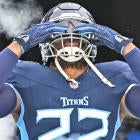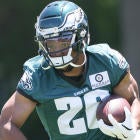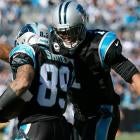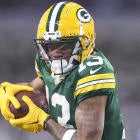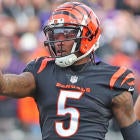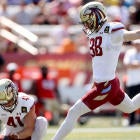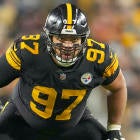If you're looking for reasons the Atlanta Falcons experienced success last season, chances are you're going to start with the offense. The Falcons racked up more yards in 2016 than all but 12 teams have gained in a single season in NFL history, and they scored more points than all but seven.
They punished teams through the air and overpowered them on the ground, using a deep and versatile group of weapons to do both. Matt Ryan had full command of Kyle Shanahan's offense. He sprayed the ball around to Julio Jones, Mohamed Sanu, Taylor Gabriel, Tevin Coleman, and Devonta Freeman on his way to leading the NFL in passer rating, yards per attempt, and touchdown rate, and ultimately being named Most Valuable Player. The offensive line kept him well-protected, and also cleared the way for Freeman to have his second straight 1,000-plus yard, 11-touchdown season.
The offense was so good, so overwhelming, that it didn't even matter that Atlanta's young defense was mostly quite bad.
The Falcons ranked 25th in yards allowed, 27th in points allowed, and 26th in Football Outsiders' defensive DVOA (defense-adjusted value over average, which adjusts performance for down, distance, and opponent). They were below-average at stopping both the pass (22nd in opponent's passer rating, 18th in DVOA) and the run (26th in opponent's yards per attempt, 28th in DVOA). Despite employing the NFL's sack leader, Vic Beasley, they also did not do a very good job of taking down the quarterback, finishing tied for 16th in sacks and just 24th in Football Outsiders' Adjusted Sack Rate.
There are, however, reasons to believe they'll improve in 2017. First, we all watched as the Falcons' defense took what sure looked like The Leap for almost their entire playoff run before completely collapsing during the second half of the Super Bowl. All that youth coalesced into a group that looked pretty damn dominant for 2.5 games. Beasley, Brooks Reed, Grady Jarrett and co. got after the passer; Deion Jones and De'Vondre Campbell made plays everywhere; and the defensive backs smothered opposing receivers.
It all came crumbling down as Tom Brady and the Patriots carved them up to complete their massive second-half comeback, but we've seen the ceiling of this defense now and it's crazy high. (Even without No. 1 cornerback Desmond Trufant.) It's also engineered to specifically succeed in the modern NFL. General manager Thomas Dimitroff and coach Dan Quinn have built a defense based around prime speed and athleticism, consistently drafting and signing players with quick burst off the snap so that they can make plays in the backfield and in space.
Take a look at the following chart, which shows the SPARQ athleticism rating, 40-yard dash time, short shuttle time, three-cone time, vertical jump, and broad jump for the notable defensive players the Falcons have drafted or signed as undrafted free agents over the last five years.
| Player | SPARQ | 40 | SHUTTLE | 3 CONE | VERT | BROAD |
| Takkarist McKinley | 116.4 | 4.59 | 4.62 | 7.48 | 33.00 | 10.17 |
| Duke Riley | 129.7 | 4.58 | 4.21 | 6.90 | 37.00 | 10.17 |
| Keanu Neal | 126.7 | 4.62 | 4.20 | 7.09 | 38.00 | 11.00 |
| Deion Jones | 129.3 | 4.39 | 4.26 | 7.13 | 35.50 | 10.00 |
| De'Vondre Campbell | 113.3 | 4.58 | 4.50 | 7.07 | 34.00 | 9.67 |
| Brian Poole | 99.7 | 4.50 | 4.43 | 7.13 | 29.00 | 9.33 |
| Vic Beasley | 151.5 | 4.53 | 4.15 | 6.91 | 41.00 | 10.83 |
| Jalen Collins | 118.8 | 4.48 | 4.27 | 6.77 | 36.00 | 10.33 |
| Grady Jarrett | 126.6 | 5.06 | 4.56 | 7.37 | 31.00 | 9.42 |
| Ricardo Allen | 112.8 | 4.51 | 4.25 | 7.01 | 37.00 | 10.17 |
| Desmond Trufant | 115.5 | 4.38 | 3.85 | N/A | 37.50 | 10.42 |
| Robert Alford* | N/A | 4.39 | 4.23 | 6.89 | 40 | 11.00 |
*Note: Alford's numbers have been edited to reflect the correct figures.
SPARQ ratings are scaled to 100, so everybody over that rating is more athletic than the average player at their position and everybody under is less so. 10 of the 12 players on the list above are above-average athletes, with many of them ranking in the 70th percentile or better among NFL players at their position.
The Falcons place a high value on a good get-off, consistently selecting players with fast 40-times. They prioritize change-of-direction skill, always being sure to grab players with good times in the short shuttle and three-cone drills, Bill Belichick-style. They don't necessarily look for high leapers, but being able to broad jump (i.e. jump to the side) does appear to hold value to the Falcons.
Each of the players above appears to have been selected to bring a specific skill. McKinley and Beasley can beat tackles around the edge with their speed and quick-twitch athleticism. Jarrett can do the same against interior linemen. Jones, Campbell, and Riley are space players capable of covering a ton of ground on the second level, whether it be exploding into the backfield to make plays or dropping deeper into the secondary to cover receivers.
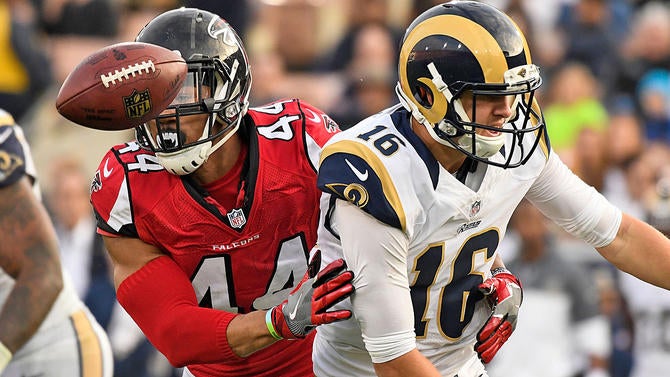
Neal is an incredibly versatile safety capable of dropping down into the box to thump running backs and sliding out into the flat to cover tight ends. He played up near the line, out on the perimeter, at linebacker, and seemingly everywhere else during his rookie season. Collins is suspended again, but Poole, Allen, Trufant, and Alford all bring plus coverage skill to the table anyway. Trufant is a bona fide No. 1 cornerback; he was lavished with a rich extension this offseason because the Falcons know he is exactly that. Alford has played his way up from being a sub-package corner to being a regular contributor; Poole emerged last season as a valuable, versatile defender capable of playing inside and out; and Allen makes for a very nice fit next to Neal on the back end.
Everything fits together nearty, with the defining theme being that they're almost all overwhelmingly athletic. With today's NFL offenses being so dedicated to spreading the field with elite athletes themselves, it's important for defenses to be able to keep up. Maybe the Falcons won't make the leap to elite status quite yet, but they have the right idea of how to get there, and they have a deep core of young talent ready to take the next step forward.














